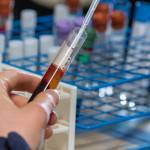Integrating Nanoparticles into Equine Nutrition

According to some, the best things come in small packages, including scientific advances that benefit horses. Nanotechnology uses minute particles—measuring 1 to 100 nanometers (nm)—to deliver various nutrients and medications to horses. For the sake of comparison, a typical atom measures 0.1 to 0.5 nm in diameter, an average virus about 100 nm wide, and a single bacterium approximately 1,000 nm. We’re talking tiny!
“Nanoparticles are added to feeds for a multitude of reasons: to serve as probiotics, improve intake and digestibility, reduce greenhouse gas production and environmental pollution, improve the structure of the gut, boost mineral absorption, enhance starch digestion by prolonging the activity of digestive enzymes, and more,” explained Kathleen Crandell, Ph.D., a Kentucky Equine Research nutritionist.
The particles can be made from various compounds. Some of the most common include silver and gold, zinc, selenium, magnesium, and copper, depending on the intended purpose of the nanoparticles.
The benefits of nanotechnology, including mechanisms of action and application of nanoparticles in equine nutrition, were recently published by a group of veterinary researchers*. As they noted, these particles can make a huge impact in the equine industry by:
- Decreasing environmental pollution associated with horse husbandry;
- Minimizing antibiotic resistance and use;
- Delivering medications;
- Reducing feed contamination, as with mycotoxins, for example; and
- Improving feed efficiency and gastrointestinal health.
Kentucky Equine Research’s Nano-E embraces the use of nanotechnology to deliver vitamin E, a powerful dietary antioxidant, to horses.
“Vitamin E cannot be synthesized by horses and therefore must be derived from the diet. Horses require approximately 1 IU/kg body weight daily for maintenance; however, working horses may require and even benefit from supplemental vitamin E to minimize exercise-induced oxidative stress,” Crandell said.
Because vitamin E is fat-soluble, adequate absorption from the gastrointestinal tract traditionally requires a small amount of dietary fat. Sometimes, a fatty meal cannot be offered at the same time as a vitamin E supplement. To overcome this requirement, Nano-E was designed to package vitamin E into tiny spheres encapsulated with a water-soluble layer.
“Nano-E is readily absorbed in the absence of a fatty meal, ready to seek and abolish free radicals that cause oxidative damage to muscles and potential tying-up episodes,” explained Crandell.
*Adegbeye, M.J., M.M.M.Y. Elghandour, A. Barbabosa-Pliego, et al. 2019. Nanoparticles in equine nutrition: Mechanism of action and application as feed additives. Journal of Equine Veterinary Science. 78:29-37.








